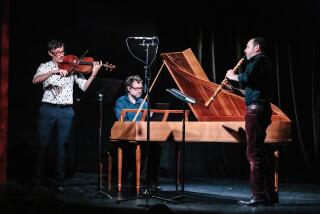PIANIST AND FLUTIST MIX CLASSICAL, JAZZ MUSIC
Time was when you could draw an easy distinction between classical and jazz musicians:
--Classical types played music exactly as it was written.
--Jazz players used the written score as a springboard for flights of improvisation.
But “we’re beyond that now,” said pianist Cecil Lytle, who will appear with flutist James Newton in a program of jazz and classical music tonight) at 8 in the Fine Arts Concert Hall at UC Irvine.
The program will include Hindemith’s Sonata for Flute and Piano, Scriabin’s Piano Sonata No. 4, Messiaen’s “Le Merle noir,” Copland’s Duo for Flute and Piano, three works by Duke Ellington, and Newton’s “Crystal Texts” and “Choir.”
“Over the last 20 to 30 years, there’s been an increasing similarity of process in jazz and classical music,” Lytle said.
“All the aleatory music (music with elements of unpredictability), for instance, brings the performer into the composition, not just to make it work, but in a very real sense to make the composition itself. Hence improvisation.
“But even Hindemith, though he’s a formalist, has a great deal of latitude in his music, and Messiaen’s music is essentially an improvisation that has been written down.
“That’s true of Beethoven, too, who was known as one of the world’s great improvisers. The fact that he wrote it down (later) doesn’t negate that.”
If classical music has been getting more improvisatory, jazz has had its own strict notators, too, according to flutist Newton:
“People like Duke Ellington--and even Jelly Roll Morton--knew exactly what they wanted and wrote what they wanted, even though they realized the specialness that each artist had to offer and included that in their language,” Newton said.
“Some of my most difficult readings come from jazz composers who wrote down exactly how their music was supposed to be played.”
A San Pedro-based musician, Newton, 32, studied classical music at California State University, Los Angeles, and in the former Los Angeles Philharmonic Orchestra Training Program. He studied jazz and flute technique with well-known jazz flutist Buddy Collette.
His “Crystal Texts,” a 14-minute work written in 1978, was written for Messiaen, he said. “It deals with his (Messiaen’s) influence upon me, especially in the area of color and color sensitivity.”
Newton characterized his “Choir,” an eight-minute flute solo composed in 1979, as “a study in multiphonics. It’s built upon four tones happening simultaneously--three moving and one held--through a combination of fingering and voice.”
Newton conceded that there’s “a different frame of mind” for playing each kind of music:
“The approach to rhythm is different, for one thing. Rhythm in classical music is very, very set, but in jazz there are countless ways of dealing with the beat. Similarly, the way you choose to attack the notes and the way you shape the phrases, also is radically different.
“But both take an awful lot of concentration. There’s no less concentration for one than for the other. In classical music, you have to adhere to what the composer wants and to the period, which is pretty much true in jazz, too, but in different ways.
“The bottom line is that it’s very challenging to play both. That’s why I play both. And I get a lot out of playing both.”
Lytle, 40, who has been teaching for 12 years at UC San Diego and who has concertized with such jazz artists as Sarah Vaughan and Thad Jones, agreed that there is “a different mind-set” for playing classical music as opposed to jazz.
“Purely classically trained musicians tend to work in a visual-to-aural process: You buy the music, you look at a set of symbols and you try to realize that in a set of gestures; the process is technical. Then you breathe life into it,” Lytle said.
“An improvisatory musician tends to work in the opposite direction--not so much on technical execution of notes, but on a conception of the work.”
When he and Newton concertize--they have been performing together for two years--they try to find music “that tends to state improvisatory material,” he said.
“The music can be fully notated, but it should have that improvisatory flavor, like Scriabin.
“It’s a question of degree,” Lytle said.
“I wouldn’t put new notes in or take some out, and I would not approach a Vivaldi flute sonata with the same degree of spontaneity as I would (Ellington’s) ‘Satin Doll.’ But without that germ of spontaneous creativity, you get a very dull performance.”
More to Read
The biggest entertainment stories
Get our big stories about Hollywood, film, television, music, arts, culture and more right in your inbox as soon as they publish.
You may occasionally receive promotional content from the Los Angeles Times.










